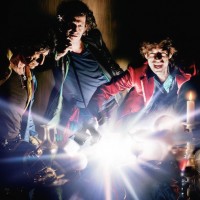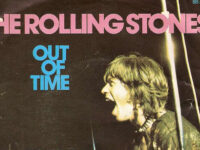Like most fans, we were hoping the Rolling Stones would pull out some deep cuts as they convened to celebrate five decades of debauched rock. What we got, however, was “Emotional Rescue” — a song they’d apparently never before performed in concert.
There’s a reason for that. Like the other songs on this excruciating list of musical misdeeds, “Emotional Rescue” will never be confused with a great Rolling Stones song. Or even a passable one. And, believe us, we know the difference after digging through this compendium of worst-ever Stones junk, all in service of our widely reviled Sucks Series.
Now, we avoided the earliest of the Rolling Stones stuff, and simply picked a representative item from their post-1980s comeback. You could, after all, fill entire lists with that stuff.
Oh, before you get any ideas, Mr. Mick Jagger, we’re not suggesting that tripe like “Fool to Cry” or “Might As Well Get Juiced” be added to your continuing 50 and Counting concert series. “Emotional Rescue” was more than enough, thank you …
[SOMETHING ELSE! REWIND: Want to hearken back to happier times? Dig into the Rolling Stones’ scalding DVD ‘Some Girls: Live in Texas ’78,’ a last blast of 1970s attitude and danger.]
“FOOL TO CRY,” (BLACK AND BLUE, 1976): A snoozy, sappy Top 10 hit from a period in which apparently the Stones could release anything and it would sell.
Anything, like say: A song with synthesized strings. Anything, like say: A song with a sessions guy on guitar, since Black and Blue — a completely aimless letdown, though we did like the shit-kickingly silly cowboy goof “Hand of Fate” — actually worked as an in-studio audition for Mick Taylor’s successor. (Ron Wood, who appears in the patently boring promotional video, would get the gig.)
Keith Richards, the story goes, actually fell asleep while playing “Fool to Cry” at a show in Germany back in 1976. Understandable.
“INDIAN GIRL,” (EMOTIONAL RESCUE, 1980): You might think any Rolling Stones song that swings into the political — much less the tangled realities of Central America — automatically qualifies for this list. But it gets worse.
Of course, there’s something patently ridiculous about a man of Jagger’s wealth and taste trying to make salient points about a life that’s “getting harder and harder.” Later, Jagger offers these similarly myopic, stunningly inappropriate sentiments: “Mister Gringo, my father he ain’t no Che Guevara.”
But what about the Floribama bar band-style intro? (You can almost hear some fun shirt-wearing yahoo yelling “Do ‘Margaritaville’ next!”) Get past that, and we completely understand if you can’t, and “Indian Girl” suddenly dissolves into something that might be best described as a mariachi-karaoke update of “Angie.” Turns out, Jagger ain’t no Antonio Aguilar, either.
“SING THIS ALL TOGETHER [SEE WHAT HAPPENS],” (THEIR SATANIC MAJESTIES REQUEST, 1967): Well, what happens is a complete disaster. Not that we fall into the camp which completely dismisses this largely bungled answer album to the Beatles’ Sgt. Pepper’s — one, by the way, that includes Richards, who famously said it was “a load of crap.”
No, it has its moments. For instance, we love the gorgeous pop confection “She’s A Rainbow” (with orchestration, by the way, courtesy of Led Zeppelin’s John Paul Jones), and the majestically doomy “2000 Light Years from Home.” But “Sing This All Together (See What Happens)” — an unfocused psychedelic jam that lasts eight minutes, and seems much longer — is one of the reasons those other, better songs rarely get heard.
It represents everything that went wrong with the unfocused, zeitgeist-chasing Satanic Majesties in a broader sense. The Rolling Stones produced the album themselves, a first, and you can tell. Anybody else would have left this mess on the cutting-room floor.
[SOMETHING ELSE! REWIND: Who didn’t come into 2005’s ‘A Bigger Bang’ expecting the generic glossy pop of their more recent output? Instead, the classic mid-period Rolling Stones sound was back.]
“MIGHT AS WELL GET JUICED,” (BRIDGES TO BABYLON, 1997): Bridges to bullshit, is more like it. Stung, perhaps, by complaints of easy classicism that dogged the earlier Voodoo Lounge, the Rolling Stones brought in some hipster elements to the follow up. That meant samples, a hip-hop guest star and several tracks — including this techno-flop — produced by the Dust Brothers, a then-white hot producing crew.
It worked just as well as nicking from the Beatles had thirty years earlier. Nothing about the Stones fits into this world, either. And quite frankly the Dust Brothers appeared to have lost something in the interim between Bridges and Beck’s Odelay, not to mention earlier triumphs like the Beastie Boys’ Paul’s Boutique. Their generically electronic backing track here is somehow both relentless and largely featureless.
As Jagger shamelessly preens, “Might as Well Get Juiced” unfolds as an overlong, unfocused and unconvincing mishap — this utterly bloodless evacuation of everything that once made the Rolling Stones dangerous. Instead, they sound like con artists.
[SOMETHING ELSE! REWIND: There was no reason to believe that the Stones, 30 years into their dangerously debauched rock career, would make anything worth a damn out of the 1990s. But they did.]
“EMOTIONAL RESCUE,” (EMOTIONAL RESCUE, 1980): As icy and detached as their 1978 comeback Some Girls had been reinvigorated and grimy, the worst song on one of the Stones’ worst albums heralded a deflating decade. And it didn’t sound any better from the stage in LA thirty-something years later.
To illustrate just how out of sync the Rolling Stones were at this point: The sessions for Emotional Rescue actually included earlier takes on “Start Me Up,” “Hang Fire” and “Little T&A,” though none of that obviously much stronger material made this album’s final version. They’d only be completed a year later when there followed some deadline pressure to finish a new studio effort.
Richards is barely present on the original date, only making any notable contributions toward the end. By then, of course, Jagger has already spent an unconscionable amount of time monologuing about some over-sexed nonsense along side a pitiably late bandwagon-jumping dance beat. (And, let’s face it, Marvin Gaye had already done the falsetto thing — and much better — on 1977’s disco classic “Got To Give It Up.”) Just go directly to Tattoo You.
- How Deep Cuts on ‘Music From Big Pink’ Underscore the Band’s Triumph - July 31, 2023
- How ‘Islands’ Signaled the Sad End of the Band’s Five-Man Edition - March 15, 2022
- The Band’s ‘Christmas Must Be Tonight’ Remains an Unjustly Overlooked Holiday Classic - December 25, 2016




